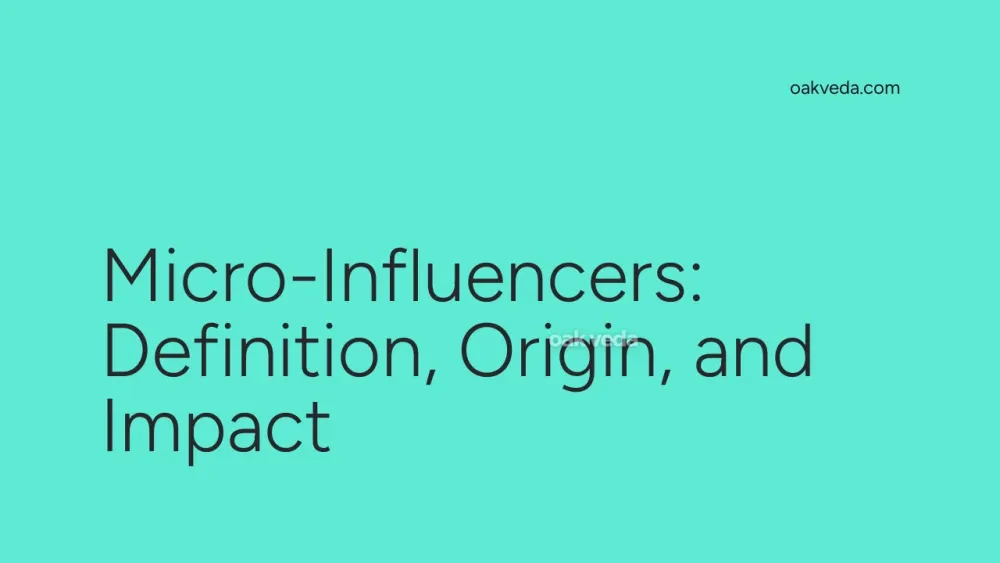
What are Micro-Influencers?
Micro-influencers are social media users with a relatively small but highly engaged following, typically ranging from 1,000 to 100,000 followers. These individuals have carved out a niche for themselves in specific areas of interest, such as fashion, fitness, food, or technology. Unlike macro-influencers or celebrities, micro-influencers are perceived as more relatable and authentic, often fostering stronger connections with their audience.
Origin and Development of Micro-Influencers
The concept of micro-influencers emerged as social media platforms matured and brands began to recognize the value of targeted, niche marketing. While the exact origin is difficult to pinpoint, the term gained traction around 2015-2016 as marketers sought more cost-effective and authentic ways to reach consumers.
As social media algorithms evolved to prioritize engagement over follower count, micro-influencers became increasingly valuable. Their ability to generate high engagement rates and foster genuine connections with their followers made them attractive to brands looking for more authentic ways to reach potential customers.
How Micro-Influencers Work
Micro-influencers operate by creating content that resonates with their specific audience. They typically focus on:
- Consistent Content Creation: Regularly posting high-quality, relevant content that aligns with their niche.
- Audience Engagement: Actively responding to comments, messages, and fostering discussions within their community.
- Authenticity: Sharing personal experiences and honest opinions, which builds trust with their followers.
- Collaboration with Brands: Partnering with companies to promote products or services that align with their values and audience interests.
Types of Micro-Influencers
While micro-influencers can exist in any niche, some common categories include:
- Lifestyle Micro-Influencers: Focus on general day-to-day life, often incorporating fashion, beauty, and home decor.
- Fitness and Wellness Micro-Influencers: Share workout routines, nutrition tips, and overall health advice.
- Tech Micro-Influencers: Review gadgets, discuss tech trends, and offer insights into the digital world.
- Food and Cooking Micro-Influencers: Share recipes, restaurant reviews, and culinary tips.
- Travel Micro-Influencers: Showcase destinations, travel tips, and cultural experiences.
Popular Examples of Micro-Influencers
While specific micro-influencers may vary by region and niche, some examples of successful micro-influencers include:
- @leefromamerica: A wellness and lifestyle micro-influencer focusing on mental health and sustainable living.
- @blackgirlswhoblog: A community-focused account showcasing black female bloggers and their content.
- @theminimalistwardrobe: A fashion micro-influencer promoting sustainable and minimalist clothing choices.
Impact of Micro-Influencers on Social Media Culture
Micro-influencers have significantly impacted social media culture in several ways:
- Authenticity: They've fostered a culture of authenticity, encouraging more genuine content creation.
- Niche Communities: Micro-influencers have helped create and strengthen niche communities around specific interests.
- Democratization of Influence: They've shown that anyone with passion and expertise can build a following and become influential.
- Shift in Marketing Strategies: Brands have adapted their strategies to include more targeted, authentic collaborations with micro-influencers.
Controversies Surrounding Micro-Influencers
While generally viewed positively, micro-influencers are not without controversy:
- Disclosure Issues: Some micro-influencers have faced criticism for not properly disclosing sponsored content.
- Authenticity Concerns: As micro-influencers gain popularity, there's a risk of losing the authenticity that made them appealing.
- Measurement Challenges: Brands sometimes struggle to accurately measure the ROI of micro-influencer campaigns.
How Brands and Influencers Use Micro-Influencers
Brands leverage micro-influencers in various ways:
- Product Reviews and Recommendations: Micro-influencers provide honest feedback on products to their trusting audience.
- Brand Ambassadorships: Long-term partnerships where micro-influencers consistently promote a brand.
- Content Creation: Brands use micro-influencers to create authentic, relatable content for their own channels.
- Event Promotion: Micro-influencers help promote local events or product launches to their engaged community.
Influencers themselves often collaborate with micro-influencers to:
- Expand Reach: Partnering with micro-influencers in complementary niches to access new audiences.
- Increase Authenticity: Larger influencers work with micro-influencers to maintain a sense of relatability.
Future Trends Related to Micro-Influencers
The future of micro-influencers looks promising, with several emerging trends:
- Hyper-Niche Influencers: Even more specialized micro-influencers focusing on very specific topics.
- Increased Use of Video Content: Platforms like TikTok and Instagram Reels are becoming crucial for micro-influencers.
- AI-Powered Matchmaking: Advanced algorithms to better pair brands with the most suitable micro-influencers.
- Emphasis on Social Responsibility: Micro-influencers are expected to take stronger stances on social and environmental issues.
- Integration with E-commerce: More direct shopping capabilities through micro-influencer content.
FAQs about Micro-Influencers
-
How many followers does a micro-influencer typically have? Micro-influencers usually have between 1,000 and 100,000 followers.
-
Are micro-influencers more effective than celebrities for marketing? In many cases, yes. Micro-influencers often have higher engagement rates and are perceived as more authentic and relatable.
-
How do I become a micro-influencer? Focus on a specific niche, consistently create high-quality content, engage with your audience, and gradually build your following.
-
How much do micro-influencers charge for sponsored posts? Rates vary widely but typically range from $100 to $500 per post, depending on factors like follower count, engagement rate, and niche.
-
What platforms are best for micro-influencers? Instagram, TikTok, and YouTube are popular, but the best platform depends on your niche and target audience.
In conclusion, micro-influencers have become a powerful force in social media marketing, offering brands a way to connect with audiences more authentically and effectively. As the digital landscape continues to evolve, the role of micro-influencers is likely to grow, shaping the future of social media engagement and marketing strategies.
You may be interested in:
- Thread: Definition, Origin, and Impact on Social Media
- Clout: Definition, Origin, and Impact on Social Media
- Delulu: Definition, Origin, and Impact on Social Media
- Rat Girl Summer: Definition, Origin, and Impact
- Hot Girl Summer: Definition, Origin, and Impact
- Glow-Up: Definition, Origin, and Impact on Social Media

